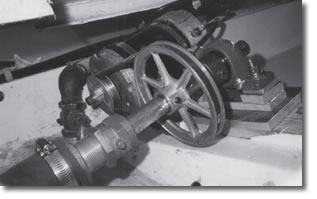List of Figures
Figure 1.1 — Baldor Golf Cart Motor, 20 ft O'Day, Various Props (1.75/1)
Figure 2.1 — Baldor Motor in Sunny 2.42 to 1 Ratio vs. 1.75 to 1 Ratio
Figure 3.1 — Sunny: the Advance DC at 24 v vs. the Baldor at 36 volts
Figure 3.2 — Efficiency Tests: 36 volts Baldor vs. 24 v Advance DC
Figure 4.1 — Sunny as an Inboard Powered by the 24 volt Motor
Figure 5.1 — Efficiency Tests 36 volts Baldor vs. 48 v GE
Figure 5.2 — Speed Comparison of Three Electrically Powered Boats and One Outboard
Figure 6.1 — Efficiency of the Etek Motor
Figure 6.2 — Input Power for Rhodes 19 vs. two Sailboats
Figure 6.3 — 3 Propellers Tested in the Water
Figure 8.1 — GE 2 hp “JB” Series DC 36 volt Motor
Figure 9.1 — Results of the Big Test
Figure 9.2 — Efficiency Tests: 3 hp AC Motor vs. GE DC Motor
Figure 9.3 — 2 hp AC Motor (Two Different Windings) vs. GE DC Motor
Figure 10.1 — Ray Electric Boats Performance Graphs
Figure 10.2 — Performance of Four Electrically Powered Boats
Figure 10.3 — Hull Resistance of Sailboats
Figure 11.1 — Power Dissipated by Propeller without Pitch
Figure 11.2 — Selecting a Propeller
Figure 13.1 — 6 volt Golf Cart Battery
Figure 13.2 — Deep Cycle Battery
Figure 2.1 — Baldor Motor in Sunny 2.42 to 1 Ratio vs. 1.75 to 1 Ratio
Figure 3.1 — Sunny: the Advance DC at 24 v vs. the Baldor at 36 volts
Figure 3.2 — Efficiency Tests: 36 volts Baldor vs. 24 v Advance DC
Figure 4.1 — Sunny as an Inboard Powered by the 24 volt Motor
Figure 5.1 — Efficiency Tests 36 volts Baldor vs. 48 v GE
Figure 5.2 — Speed Comparison of Three Electrically Powered Boats and One Outboard
Figure 6.1 — Efficiency of the Etek Motor
Figure 6.2 — Input Power for Rhodes 19 vs. two Sailboats
Figure 6.3 — 3 Propellers Tested in the Water
Figure 8.1 — GE 2 hp “JB” Series DC 36 volt Motor
Figure 9.1 — Results of the Big Test
Figure 9.2 — Efficiency Tests: 3 hp AC Motor vs. GE DC Motor
Figure 9.3 — 2 hp AC Motor (Two Different Windings) vs. GE DC Motor
Figure 10.1 — Ray Electric Boats Performance Graphs
Figure 10.2 — Performance of Four Electrically Powered Boats
Figure 10.3 — Hull Resistance of Sailboats
Figure 11.1 — Power Dissipated by Propeller without Pitch
Figure 11.2 — Selecting a Propeller
Figure 13.1 — 6 volt Golf Cart Battery
Figure 13.2 — Deep Cycle Battery
